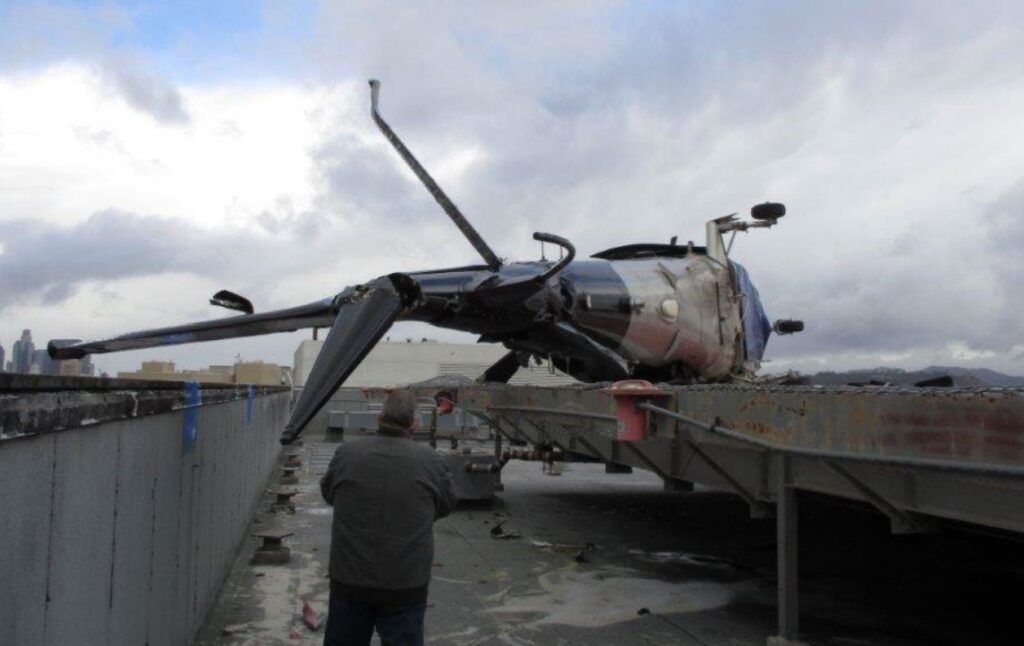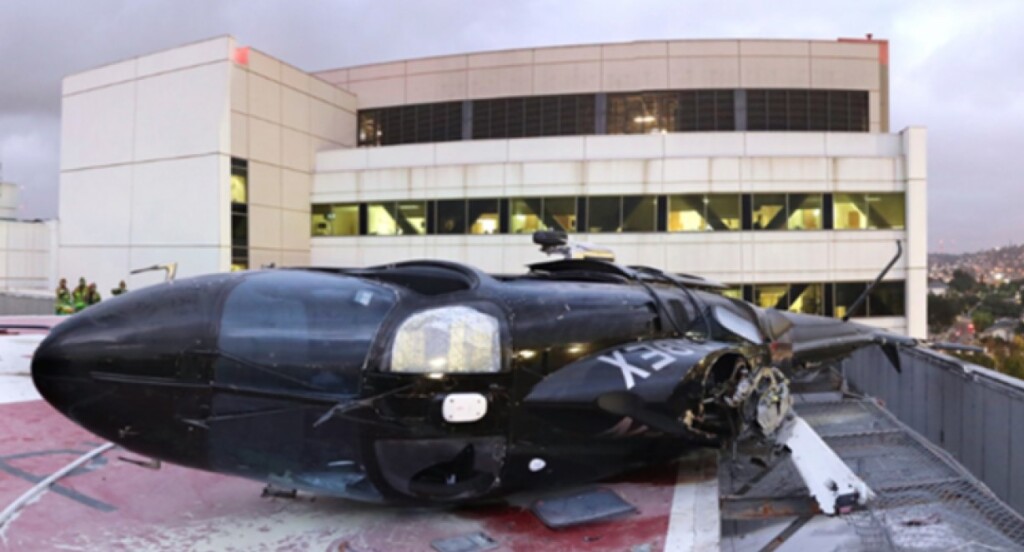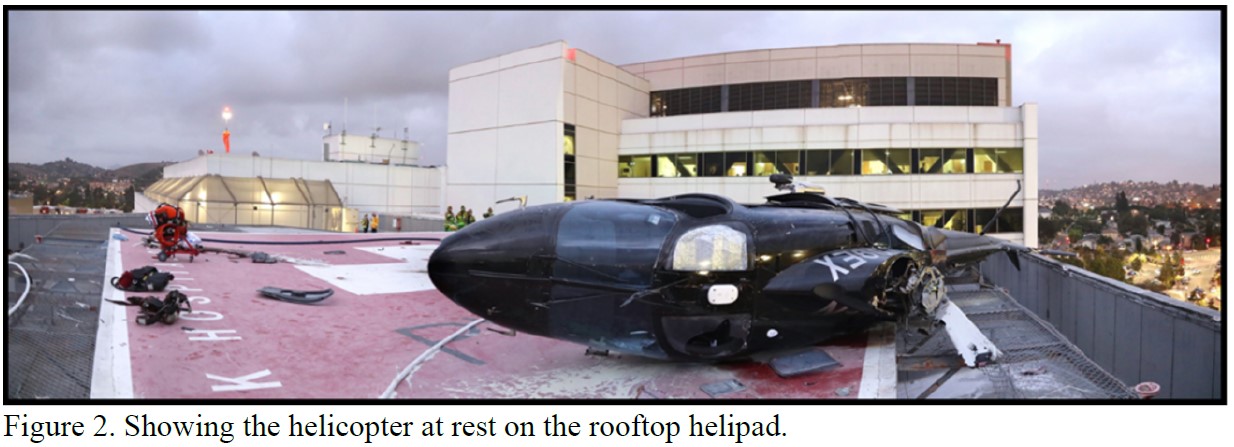NTSB on Los Angeles A109S Rooftop Hospital Helipad Landing Accident (N109EX of Helinet Aviation Services / Prime Healthcare at USC Kerk)
The US National Transportation Safety Board (NTSB) have published their preliminary report on Leonardo Helicopters AW109S N109EX of Helinet Aviation Services which crashed onto the University of Southern California (USC) Keck Medical Center (USC Keck) rooftop helipad in Los Angeles, California on 6 November 2020. UPDATE 28 January 2023: NTSB have now published further factual information (see below) that puts attention on the tail rotor and past inspections.

Wreckage of Helinet Aviation Services / Prime Healthcare Leonardo Helicopters A109S N109EX on Rooftop Helipad of Los Angeles Co/USC Kerk Medical Center Heliport (35CA), Los Angeles, CA (Credit: via NTSB)
The helicopter was making a Part 135 helicopter air ambulance flight, with a donor heart for a transplant operation aboard. The pilot suffered minor injuries and the two passengers were uninjured. The Los Angeles Fire Department (LAFD) retrieved the organ from the wreckage and the hospital says “the heart was successfully transplanted following the crash, and the transplant recipient is recovering well”.
The Accident
The US National Transportation Safety Board (NTSB) explain in their preliminary report that:
The pilot reported that he established the helicopter in a steep approach, to land on the rooftop helipad of a multi-story medical building [approaching in a northerly direction over Hazard Park according to videos of the accident].
The pilot had offset his heading to the left to gain greater visibility to the landing zone. He observed the absence of any wind indication from the windsock and no movement on nearby trees. When the helicopter had decelerated to about 45 knots, he increased the engine and rotor RPM to 102%.
About 40 feet above the helipad, the pilot noticed a slight yaw to the right that continued despite full left pedal application. He thought to fly away from the helipad when the helicopter aligned in the direction he just approached from. As the helicopter rotated to about 90° from his approach heading, it suddenly and very violently made a dramatic increase in right yaw.
Realizing the helicopter was going to be uncontrollable, the pilot “dumped the collective” and tried to stay over the helipad. He stated that after the helicopter struck the helipad, it rolled left and continued spinning on its side, and eventually came to a stop.
The pilot shut down the engines and all three occupants exited unassisted.
The NTSB say that:
A review of a witness video, (See figure 1), taken from an adjacent building, revealed the helicopter approached the rooftop helipad while slowly rotating clockwise about the vertical axis.
The helicopter stopped descending and rotated 360°. The helicopter then descended while rotating an additional 180° and rolled to the left before impacting the helipad. The main rotor blades contacted the helipad, followed by the left main landing gear and the fuselage. The helicopter descended out of view of the camera.
The helicopter came to rest on its left side, on the helipad.
The four composite blades of the main rotor system fragmented and separated, spreading debris throughout the rooftop and down to the ground. The tail rotor and 90° gearbox separated and were found on the rooftop. The left main landing gear separated and remained near the attachment points of the fuselage.
UPDATE 28 January 2023: NTSB Safety Investigation Factual Report: Focus on Tail Rotor Ring Nut
NTSB investigators have revealed that the tail rotor assembly rotating control ring nut was separated from the thrust sleeve assembly.

Helinet Aviation Services / Prime Healthcare Leonardo Helicopters A109S tail rotor rotating controls, showing the ring nut, and thrust sleeve (Credit: FAA via NTSB)
No other pre-impact defects were found.
Examination of the tail rotor assembly and 90° gearbox by the NTSB Materials Laboratory revealed a step, or worn footprint, in the bottom surface of the ring nut at the outside diameter edge.

Helinet Aviation Services / Prime Healthcare Leonardo Helicopters A109S: Image showing the step or worn footprint on the accident ring nut, and an exemplar ring nut (Credit: NTSB & Leonardo via NTSB)
The threads of the outer diameter of the ring nut and the inner diameter of the thrust sleeve appeared intact. Examination of the grease for trace amounts of required locktite were inconclusive.
Leonardo advised the NTSB there had been four previous events associated with loss of tail rotor control and the ring nut. There first three were between December 2010 and October 2014. Afterwards Leonardo…
….made changes to maintenance procedures that included increasing the ring nut torque value, dual lockwire application, the application of Loctite to the ring nut, adding a note to the maintenance manual to ensure the duplex bearing is properly seated, and procedures to improve the cleaning and greasing operation of the duplex bearing.
The European Union Aviation Safety Agency (EASA) issued an emergency airworthiness directive (EAD), 2012-1095E [sic actually 2012-0195-E], dated September 25, 2012. The reason for the EAD was “Cases of loosening of the tail rotor duplex bearing locking nut Part Number (P/N) 109-0130-97 have been reported on [A109E, A109LUH, A109S, AW109SP, A109C, and A109K2] helicopters. The investigation identified the absence or the damage of one or both of the locking wires securing the tail rotor duplex bearing locking nut P/N 109-0130-97.”

The helicopter manufacturer issued five Technician Bulletins (Bollettinos Tecnico) in September 2012, for all affected models. The bulletins required, in part, a visual inspection of the lock wire (s) securing the tail rotor duplex locking nut to the housing, periodic inspection (every 25 hours) to verify the condition of the two locking wires until compliance with disassembling and reassembling of the housing and slider group of the tail rotor rotating controls.
Despite an EASA Emergency AD the FAA only issued Airworthiness Directive (AD) 2014-02-08 on 7 March 2014, 19 months later. Disappointingly the NTSB don’t comment on the FAA’s initial lack of airworthiness alacrity.
A fourth failure occurred on October 21, 2014, after the housing and slider group of the tail rotor rotating controls had been reassembled. Consequently, the FAA superseded the AD 2014-02-08 with AD 2015-11-08, dated June 24, 2015…
This eliminated disassembly and reassembly as an AD terminating action and required a daily check by the pilot of the locking wire.
The NTSB investigation into the N109EX’s accident included a review of the technical records, which…
…revealed that the helicopter was maintained in accordance with the manufacturers extended maintenance program. The most recent 400-hour extended maintenance check, which included the disassembly, and inspection of the rotating controls was completed on May 17, 2019, at a Hobbs time of 1,149.2 hours.
This was 300 flying hours prior to the accident
The accident pilot had signed off the tail rotor lockwire inspection on November 6, 2020, at 11:20 hours. Prior to that, the previous pilot had signed off the tail rotor lockwire inspection on November 6, 2020, at 04:00 hours.
Part of one lock wire was found attached to the thrust sleeve after the accident.
The pilot had flown 4,579 hours in total, but only 81 on type.

Helinet Aviation Services / Prime Healthcare Leonardo Helicopters A109S: The left photo shows part of one locking wire attached to the accident sleeve, and the right photo shows an exemplar locking wire from a different helicopter (Credit: FAA via NTSB)
According to the manufacturer a new tail rotor dual lock duplex bearing support has been developed that incorporates a more robust locking system and is compatible with the current duplex bearing. The target for certification is the fourth quarter of 2022 and will be retrofit through service bulletins.
NTSB Probable Cause
UPDATE 31 January 2023: The NTSB determined the following as ‘probable cause’ to be:
The loss of tail rotor control due to the separation of the tail rotor duplex bearing ring nut from the thrust sleeve, which resulted in the loss of helicopter control.
This is simply a statement of what happened just before impact not why it happened. They identified no contributor factors and made no safety recommendations.

Wreckage of Helinet Aviation Services / Prime Healthcare Leonardo Helicopters A109S on Rooftop Helipad of Los Angeles Co/USC Medical Center Heliport (35CA), Los Angeles (Credit: NTSB)
Safety Resources
The European Safety Promotion Network Rotorcraft (ESPN-R) has a helicopter safety discussion group on LinkedIn. You may also find these Aerossurance articles of interest:
- Air Ambulance Helicopter Fell From Kathmandu Hospital Helipad (Video)
- HEMS A109S Night Loss of Control Inflight (N91NM)
- Air Ambulance A109S Spatial Disorientation in Night IMC (N11NM)
- HEMS Black Hole Accident: “Organisational, Regulatory and Oversight Deficiencies”
- HEMS S-76C Night Approach LOC-I Incident
- Life Flight 6 – US HEMS Post Accident Review video and emergency response lessons from a US night accident
- Hanging on the Telephone… HEMS Wirestrike
- Air Ambulance Helicopter Downed by Fencing FOD
- Ambulance / Air Ambulance Collision
- Deadly Dusk Air Ambulance Bird Strike
- UPDATE 23 January 2021: US Air Ambulance Near Miss with Zip Wire and High ROD Impact at High Density Altitude
- UPDATE 31 January 2021: Fatal US Helicopter Air Ambulance Accident: One Engine was Failing but Serviceable Engine Shutdown
- UPDATE 29 May 2021: Air Ambulance B407 Hospital Helipad Deck Edge Tail Strike During Shallow Approach
- UPDATE 31 July 2021: Low Recce of HEMS Landing Site Skipped – Rotor Blade Strikes Cable Cutter at Small, Sloped Site
- UPDATE 21 August 2021: Air Methods AS350B3 Night CFIT in Snow
- UPDATE 19 September 2021: A HEMS Helicopter Had a Lucky Escape During a NVIS Approach to its Home Base
- UPDATE 23 December 2021: Air Methods AS350B3 Air Ambulance Tucson Tail Strike
- UPDATE 21 January 2023: After Landing this HEMS Helicopter Suddenly Started to Slide Towards it’s Hangar…
And:
- The Tender Trap: SAR and Medevac Contract Design Aerossurance’s Andy Evans discusses how to set up clear and robust contracts for effective contracted HEMS operations.





Recent Comments